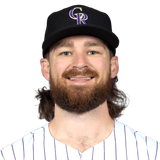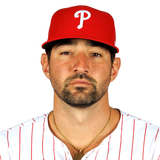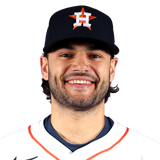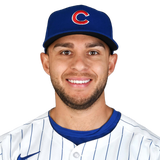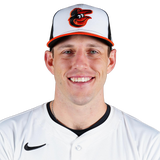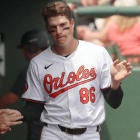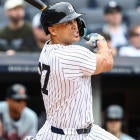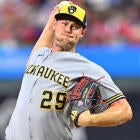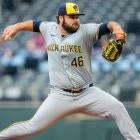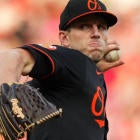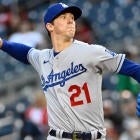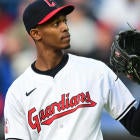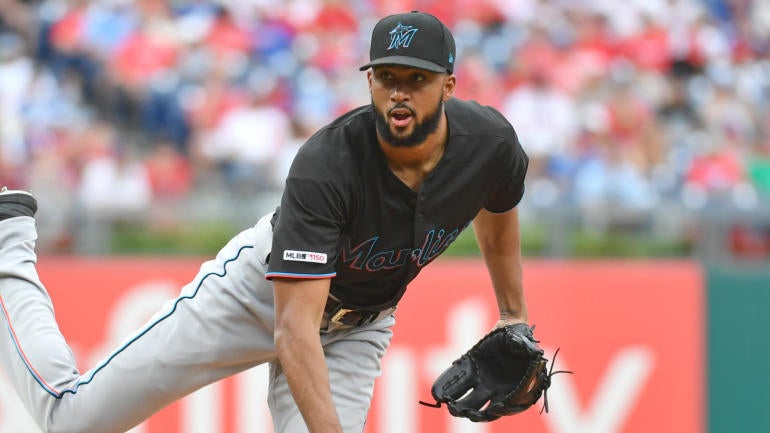
The "breakouts" label doesn't get as much attention, but this list I'd argue is even more fun than my Sleepers 3.0. The players here are generally more established but have higher ceilings overall, with evidence suggesting they're on the verge of reaching them this year.
Would they qualify as sleepers as well? Sure, there's an element of buying them for less than I think they'll be worth. But mostly, it's about how big the production could be.
I've said it before and I'll say it again: Of all the lists I make consisting of players I like, this one has the highest concentration of players I actually draft.
Scott White's Sleepers 3.0 | Busts 3.0
The Newcomers
| ||||||||||||
Sandy Alcantara has already established himself as an innings eater, going six-plus in six of his seven starts last year and seven-plus 11 times in 2019. He's known for putting the ball on the ground and keeping it in the yard. What keeps him an also-ran in the starting pitcher rankings is his lack of strikeouts, which is all the more glaring given the way he lights up the radar gun. Not every 98 mph reading, though, is the same pitch but two thrown almost equally. While the two-seamer may be largely responsible for the weak contact and ground balls, it's the four-seamer that has a chance to be special. And Alcantara seems to know it.
"I've got to use more my four-seamer," he said early in spring training. "I think that's my best pitch right now."
The swinging-strike rate on Alcantara's four-seamer last year was just over 14 percent, which is about as high as you'll see for that pitch. Max Scherzer's was right in that same range. So given Alcantara's intention of using the pitch more and its effectiveness last year, might it be no coincidence that he has 24 strikeouts in 17 1/3 innings this spring, including nine in five shutout innings last time out? If his bat-missing ability becomes a strength rather than a weakness, it's a quick path to acedom.
| ||||||||||||
The difficulty in assessing Shohei Ohtani is that he's basically two players. The hitter version has been mostly successful but sparsely used. The pitcher version has been kept on ice for the better part of two years. Both were abject failures last year, but Ohtani wasn't right physically, still recovering not only from Tommy John surgery but also a knee procedure that led to some bad habits at the plate.
The work he put in this offseason is evident. No matter the role this spring, he has looked like the most talented player on the field, handcuffing batters with a diving splitter and routinely hitting balls over the center field batter's eye -- some in excess of 450 feet. In terms of pure numbers, the hitting side has been most impressive -- he entered play Friday having gone 12 for 20 with four homers compared to just two strikeouts -- but the pitching side is in higher demand in Fantasy. When we last saw him healthy in 2018, remember, he had a 3.31 ERA, 1.16 WHIP and 11.0 K/9 in 10 starts.
What's most significant about drafting Ohtani this year, though, is that manager Joe Maddon is dialing back the restrictions that have defined the 26-year-old's time in the majors so far, potentially keeping him in the lineup the day before and/or after he pitches. So if the pitching side doesn't work out, all you have to fall back on is a guy with the capacity for 30 homers, 20 steals and a .900 OPS who's now in line for near-everyday at-bats. No way he's making it to Round 15, like the ADP suggests -- not with the spring he's had.
| ||||||||||||
This situation is kind of like the one I described for the Braves' Will Smith in Sleepers 3.0. Manager David Bell hasn't named Amir Garrett the closer, so people aren't drafting him like one. But that's just the way managers operate now, which means we have to rely on inference. The Reds brought in left-hander Sean Doolittle to be a late-inning reliever for them. He's been terrible this spring, but it sounds like that's still the plan. Garrett also throws left-handed. Lucas Sims, Garrett's primary competition for saves, throws right-handed. Wouldn't the Reds want to keep the one righty more flexible?
And then there's this: "I feel like it's still mine," Garrett said of the closer gig early in camp. "I'm not competing with anybody. I'm competing with myself." At every chance to speak on the matter, he has taken ownership of the closer role. Is he pulling the idea out of thin air? How will it go over if he doesn't get it?
I suppose it's possible Garrett and Sims split the role, one working the eight and one working the ninth based on matchups, but apart from Gabe Kapler in San Francisco, Kevin Cash in Tampa Bay and maybe Rocco Baldelli in Minnesota, few managers have shown the stomach to stick with such an approach. Fact is the cost makes it a no-risk proposition. My ideal approach to saves, so as not to pay too much for a volatile and fungible contribution, is to draft the Braves' Smith as my No. 1 and Garret as my No. 2. I'll do it in every league.
| ||||||||||||
Tarik Skubal's didn't have much incentive to develop more than a fastball in the minors, not when he was delivering 17.4 K/9 over nine Double-A starts two years ago, but in the majors, something offspeed is obviously required. He found more success when he began mixing in a changeup more down the stretch last year, but it still wasn't a pitch he could rely on, which is why he worked with Driveline Baseball, a data-driven development program in Seattle, to develop more of a split-finger version this offseason.
It's a big reason Skubal has 15 strikeouts in 12 two-run innings this spring. The way his entire arsenal has come together, with non-fastballs accounting for eight of his 12 swinging strikes last time out, points to a pitcher who's about to make a big leap forward. Seeing as he managed a 10.9 K/9 rate and Trevor Bauer-like 12.9 percent swinging-strike rate while working with just one good pitch last year, even one more could be revelatory.
| ||||||||||||
Shoulder injuries the past two years have prevented Brendan Rodgers from making good on the potential that once made him the No. 3 pick in the draft, and above, you'll note the numbers from his last minor-league stint at Triple-A Albuquerque. His opportunities at the major-league level were sporadic in the past, but he has a clear path to playing time now. It's not mere conjecture. The stated plan with Nolan Arenado gone is for Ryan McMahon to shift back to his natural position so that Rodgers can step in at second base.
Of course, then he went and strained his hamstring in spring training, delaying that plan for about a month. But the upside is still high enough and the opportunity still palpable enough to stash him away in an IL spot to begin the year.
We know the story with Coors Field. Anyone who plays there sees a big BABIP boost and a bunch of flattened breaking balls because of the thin air. It's a hitter's haven like none other, and few in the franchise's history have come along as talented as Rodgers. He was a bigger prospect than Trevor Story or Charlie Blackmon. He even mentioned earlier this spring that he aims to steal 20 bags.
Particularly at a weak position, why is the interest almost nonexistent? Because his first 97 major-league at-bats the past two years went so poorly? Are you even listening to yourself?
The Holdovers
| ||||||||||||
Zach Plesac has gone from relative nobody to a fairly high draft pick in the span of the eight starts he made last year, so you might argue the breakout already happened. But seeing as he was the No. 3 starting pitcher in Head-to-Head points per game, ranking behind only Cy Young winners Shane Bieber and Trevor Bauer, drafting him just inside the top 25 starting pitchers isn't taking full account of his upside.
Last year, he made the simple change that has brought out the best in so many of his contemporaries: He emphasized his best pitches, throwing his not-so-special fastball about one-third of the time instead of half. His slider and changeup, both already superior pitches, became even more effective, each generating whiffs at an elite rate, and yet even with his reliance on secondary pitches, he dominated the strike zone, ranking eight in strike percentage and third in walks per nine. Most significant is what that efficiency meant for his workload. Not a single starting pitcher went seven-plus as consistently as Plesac did last year, and not one of his eight starts went less than six innings. For starting pitchers in today's MLB, working deep is half the battle.
Sure, an eight-start sample isn't enough to determine anything conclusive about Plesac, but the bottom line is that the number of starting pitchers who will genuinely matter in Fantasy Baseball is finite. It takes skills, and it takes volume. And in Plesac's case, if the skills are even enough for him to live up to his 3.38 xERA or 3.50 xFIP, much less the 2.28 ERA, then we already have evidence he'll get the volume he needs for those skills to matter.
| ||||||||||||
Last year, I became so enamored with Nick Castellanos' potential in Cincinnati's ballpark that I began comparing him to early-round mainstays like Nolan Arenado and J.D. Martinez. Won't you join me in doubling down?
Sure, it seems like it was woefully misguided at first glance, but a second glance will show you that he deserved much better than he got, with Statcast putting his expected batting average at .273 and expecting slugging percentage at .542. And that was with a career-worst strikeout rate that's easy enough to attribute to the small sample. More than anything, though, it's Castellanos' .257 BABIP in spite of his typically elite line-drive rate that suggests he was a hard-luck case all the way around. He's about where Marcell Ozuna was at this time last year in terms of expected results vs. actual results, and a comparable course correction would be unsurprising.
| ||||||||||||
James Karinchak is one of those breakout picks that risks being too obvious since most everyone sees the 17.7 K/9 (tied with Devin Williams for tops among relievers last year) and recognizes that Brand Hand is now out of the picture for Cleveland. But when it comes to actually drafting him, there's some hesitance that I think creates real opportunity.
Yes, Terry Francona hasn't officially given him the job yet, but few on the Indians beat are treating it as a true competition, instead, they're calling Karinchak a "heavy favorite" while listing off a few token alternatives. And seeing as Karinchak was long rumored to be the reason the Indians might move on from Hand, what would stop him from claiming the ninth-inning role now? The walk rate? It's true that 5.3 per nine innings is high, but when he's striking out half the batters he faces, the math changes for everything else. Teams don't score on walks alone.
And make no mistake, Karinchak's bat-missing is historic, positioning him as of the few relievers, much like Josh Hader, who'll hang with certain starting pitchers in the strikeout category. For crying out loud, he had more strikeouts than Max Fried last year. That kind of upside warrants a glass-half-full approach.
| ||||||||||||
After going 106 appearances without a double digit-strikeout effort, Joe Musgrove had two to end 2020. It goes to show you what kind of heights he was reaching after overcoming an early triceps issue, regaining the velocity on his fastball and playing his slider off his curveball in a way he never had before. His 14.4 percent swinging-strike rate would have ranked among the top 10 qualifiers, alongside Yu Darvish, and his 3.19 xFIP was better than that of Trevor Bauer. Musgrove has historically been an elite strike-thrower, allowing him to pitch six and seven innings with ease, and now with San Diego, he has the supporting cast to make it hold up.
| ||||||||||||
Lance McCullers has long stood out for both his ground-ball rate (which would have ranked second among qualifiers last year, behind only teammate Framber Valdez), and his potential to strike out 10 batters per nine innings. Pitchers who excel at both are rare, and McCullers' ratios, in particular, would suggest a Luis Castillo-like outcome is possible.
His biggest issue is that he hasn't held it together long enough, having yet to throw even 130 innings in a major-league season despite debuting in 2015. He'll be in good company if he reaches that modest total this year, though, given how careful organizations figure to be with their most coveted hurlers after a shortened 2020, and it's still possible McCullers blows away his previous high now that his 2018 Tommy John surgery is fully behind him.
By the way, he wasn't quite himself early last year, coming off the procedure. The curveball that he normally lives and dies with, featuring it about 50 percent of the time, didn't get that same usage early on. Only in his final three starts did McCullers throw it so prominently. And how did those go? He had a 0.00 ERA, 0.62 WHIP and 12.2 K/9.
| ||||||||||||
I've had a hunch with Ke'Bryan Hayes for a while now that he might ultimately go the Francisco Lindor route. Both failed to deliver numbers befitting their prospect standing in the minors but generally put the bat on the ball, met a certain athletic standard best exhibited through their defense, and retained glowing scouting reports throughout their ups and downs. Any prospect has a chance of taking another step forward upon reaching the majors, but the ones like Lindor and Hayes who have already cleared the biggest hurdle for maximizing raw ability -- i.e., putting the bat on the ball -- seem especially poised to do so.
The Braves' Cristian Pache also fits the bill, for what it's worth, but for now, let's stick with Hayes, who showed the earliest signs of it last September with elite exit velocities and more over-the-fence power than he ever showed in the minors. His high contact rate and all-fields approach should make him a cinch for batting average, and he's athletic enough to swipe 12-15 bags as well. If he comes closer to 30 homers than 20, which seems all the more possible given his 2020 debut, we're talking about a guy who gets drafted in the first four rounds next year.
| ||||||||||||
Kevin Gausman is no stranger to breakout lists, least of all mine. But last year, right about the point when everyone had given up on him, the 30-year-old showed his clearest signs of a breakout yet, going from never striking out even a batter per inning to having nearly 12 strikeouts per nine. That rate would have ranked eighth among qualifiers, just ahead of Gerrit Cole, and he had the swinging-strike rate to match, ranking just behind Cole at 15.2 percent. Gausman's splitter has always been an elite swing-and-miss pitch, and by leaning on it more, his fastball began playing up, too.
It's worth pointing out he had just one double digit-strikeout effort in 2020, getting built up slower because of a balky elbow, but he began throwing six innings with consistency in September and made such believers of the Giants that they extended him a qualifying offer (which he accepted for $18.9 million). The usual sample size caveats of course apply, particularly for someone with Gausman's uninspiring track record, but since he only requires a mid-round investment, it's another case of the reward far outweighing the risk.
| ||||||||||||
As with Karinchak, the hesitance with Clint Frazier seems to have more to do with his role than his actual performance, but manager Aaron Boone has reiterated, both before and after the Yankees brought back Brett Gardner, that Frazier will retain the starting left field job he claimed early on last year. And well, why wouldn't he? Having finally put the 2018 concussion behind him and made some tweaks to his batting stance that helped him recapture what GM Brian Cashman once described as "legendary" bat speed, Frazier finally made good on his prospect hype last year, averaging about as many Head-to-Head points per game as Michael Conforto.
The power wasn't as surprising as the plate discipline, but since the climbing walk rate was evident as early as last spring, I'm not so quick to dismiss Frazier's .394 on-base percentage. If he contributes something like it along with 30 homers and 10 steals, you'll get well more than you paid for.
| ||||||||||||
Over the course of his minor-league career, Tyler Mahle was able to dominate to the tune of a 2.87 ERA on the strength of his fastball alone, and it made him effective for stretches during his first three years in the majors as well. But due to his overreliance on that one pitch, he was pretty much toast the third time through a lineup and, thus, difficult to trust as a traditional starting pitcher.
That all changed last year when he unveiled a slider that functioned as a swing-and-pitch in its own right. Classified as a cutter on some tracking systems because of the way it moves, it served as such an effective counter to his fastball that its effectiveness shot way up, too, resulting in a K/9 rate (11.3) and a swinging-strike rate (13.8 percent) that ranked among the elites. And perhaps most revealing, the hitters Mahle faced a third time through the order went only 2 for 31 against him. That's compared to 34 for 97 (.351) with a 1.004 OPS in 2019, and it makes him someone the Reds can trust to leave out there six or seven innings at a time.
| ||||||||||||
Second base is arguably the weakest position, stolen bases the scarcest contribution and batting average the most difficult category to bolster late. Nick Madrigal, a player going just inside the top 200 on average, could be a significant contributor to all three. He's so uniquely suited to meet several scarcities that his late-round availability is almost too good to be true. And seeing as he's a consensus top prospect with a starting job all but locked up already, it doesn't make much sense either.
Now look, he's a virtual zero for home runs, and at a time when everybody who's anybody has the capacity for 20 or more, it puts a clear limit on his upside. It's also possible that some people are waiting to see how he rebounds from an October shoulder surgery, but for a non-power hitter, any concerns in that area are probably overblown. There's certainly no doubting Madrigal's contact skills. He struck out 21 times in 707 minor-league plate appearances, which makes his 6.4 percent major-league rate look like he's swinging from his heels, and while the steals potential hasn't fully revealed itself yet, he stole 35 bases in his latest minor-league season.
| ||||||||||||
John Means' spike in velocity (about 2 mph) was there from the start of 2020 but easy enough to overlook when it didn't make for better results. That all changed after six starts, though, when his swinging-strike rate jumped from its typically uninspiring 8.7 percent to a Gerrit Cole-like 15.7 percent for his final four starts. What it meant for his forward-facing numbers was just as notable: His K/9 went from 5.4 to 11.4 and his ERA from 8.10 to 1.52.
Maybe it was just a weird blip to end a weird season, or maybe it was the logical next step for a pitcher who saw one of the biggest improvements in pure stuff and already had a mastery of the strike zone, issuing no more than one walk in any of his 10 starts.
Why is Vladimir Guerrero Jr. rising in Chris Towers' rankings? Check out the Fantasy Baseball Today in 5 podcast embedded below, and make sure you subscribe at Apple, Spotify or anywhere else you get your podcasts for more of our comprehensive draft prep coverage:
The Dropout
| ||||||||||||
Reason for removal: Smith of course still has breakout potential. He has 23 homers in 284 career at-bats. His strikeout rate dropped from a Pete Alonso-like 26.5 percent in 2019 to a Whit Merrifield-like 16.1 percent last year. Those numbers make a compelling enough case on their own. But as short as last season was, there's value in factoring in the postseason numbers as well, and when you do, Smith's batting average becomes .257 and his strikeout rate 21.7. Yes, it was a truly dreadful month of October.
And then when you look at the way the Dodgers handle the catcher position, rarely starting anyone more than three days in a row even going back to the Yasmani Grandal days, I just wonder if the production will be quite big enough and the playing time quite consistent enough to justify the ADP. Turns out I have yet to actually draft Smith, and I don't remember an instance of even considering it.
So which Fantasy baseball sleepers should you snatch in your draft? And which undervalued first baseman can help you win a championship? Visit SportsLine now to get Fantasy baseball rankings for every single position, all from the model that called Will Smith's huge breakout last season, and find out.
















